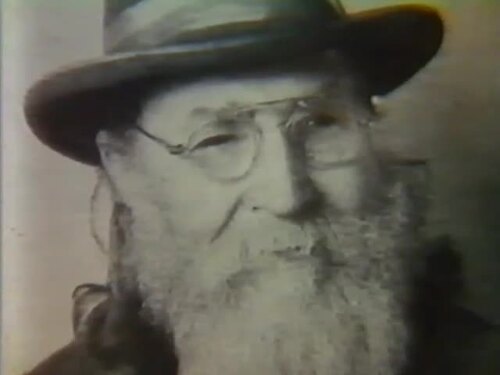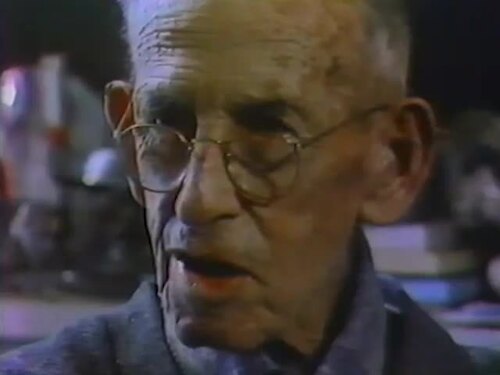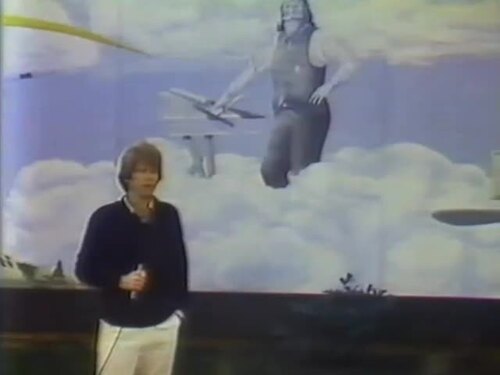Enter a name, company, place or keywords to search across this item. Then click "Search" (or hit Enter).
Collection: Videos > Documentaries
Video: KCRA Channel 3 Segment on Lyman Gilmore (7 minutes)
This is a KCRA Channel 3 history segment called "On The Go" with John Gibson about Lyman Gilmore, an aviation pioneer in Grass Valley, California. Lyman Gilmore built an aerodrome and several airplanes in the early 1900s. He may have flown one of his aircraft in 1904, witnessed by a teenager named Charles Harris. Gilmore also claimed to have flown a steam-powered glider in 1902, before the Wright Brothers. A teacher named Stephen Barber researched Gilmore and uncovered many of his writings and designs. Gilmore was a gold miner but dedicated much time to designing airplanes. In the 1920s, a film crew documented Gilmore and his brother showcasing one of their aircraft. A fire later destroyed the hangar, airplanes, and many of Gilmore's papers in 1934. Gilmore died shortly after being hospitalized.
Full Transcript of the Video:
It must have been a strange sight. 1904 in Grass Valley, California, a huge barn-like building, actually an aerodrome or airplane hangar, and not far away, an airplane. It's engines humming about to take off. I heard this big racket, and I looked right across this road and saw Gilmore turning up his ship. Everywhere you looked, man was finding his wings. This may be a very important site in the history of aviation. From 1904 to 1934, this was the site of the Gilmore Brothers Aerodrome and Airstrip. Together, the Gilmore Brothers built two advanced design aircraft. They may have flown one of them. Today, Lyman Gilmore's Airstrip is a playground at the school named after him. Seven years ago, a teacher at that school, Stephen Barber, asked, Who is Lyman Gilmore? No one seemed to know, and Barber began his research. Barber has uncovered thousands of pages of Lyman Gilmore's writings, patented applications, blueprints, and designs. What those papers show is a partial portrait of a visionary ahead of his time in aeronautical design, whose most ambitious designs were built but were never actually flight tested. Lyman Gilmore made his living as a gold miner, but his lifelong interest was flying, and he spent much of his time and effort designing airplanes. If we can believe his journals, it is also apparent he did quite a bit of flying, mostly in gliders pulled by horse teams. But his journals also contain a claim to have flown a steam-powered glider in 1902, at least a year before the Wright Brothers. If true, it must have been an awesome sight. A bearded white man soaring above the heads of the Indians of Placer County, the only witnesses to the event, if it really happened. He watched birds from the time he was a small child, and handmade bird-like objects threw them in the air. And when he grew up he had more dream experiences, vision experiences, and created his aircraft from those dreams. One thing is certain, Gilmore did design airplanes far ahead of his time. He sold stock in his airship company, and in 1904 he took the smaller of his two airplanes out on his airstrip and took off. The only witness to that sight still alive today is Charles Harris, now 90, a teenager back then. It was on a Saturday that I used to go out and help my dad to clean up these roads. Well, I saw it, I heard this noise and I didn't know what it was. So I climbed a tree there, I just looked right across the road, and I could see the airplane, I saw it moving. And I stayed there for a little while, pretty soon. You saw it go into the air? It didn't go too far, but it was off the ground, the whole four wheels, sorry what it was. In the 1920s, years after Lyman-Gilmore actively pursued flight, a film crew came to Grass Valley and shot this footage at the Gilmore Aerodrome. Lyman and his brother Charles gladly showed the big-air machine off to the camera. They swept years worth of dust off its tattered fuselage and wings, and hand turned its powerless prop. Then they climbed into the cabin for a picture. Within a few years, fire claimed the hangar, the two airplanes, and much of Lyman-Gilmore's lifelong collection of papers. Gilmore was an unusual old character in the Grass Valley, Nevada City area. He never shaved or cut his hair, and he almost always wore a long black coat. When he wasn't sick, he was hospitalized in Nevada City. The doctors and nurses cut his hair, shaved his beard, and burned the old coat. Lyman died shortly after leaving the hospital, defeated, old, and according to legend, broke. His lifelong savings hidden in the lining of the coat that was burned. He had stipulated in his will that none of his papers or designs could be released to the public until 25 years after his death. That date was 1976, but today still much of that material is being held secret by Lyman-Gilmore's relatives. Many of the answers to questions about Lyman-Gilmore went up in smoke with his aerodrome when it burned in 1934, as is depicted here on the side of the Lyman-Gilmore school in this mural. To this day, Lyman-Gilmore remains a mystery. It is possible that some of these questions could be answered if the living relatives of Lyman would release documents and other papers of his that they have. But so far they haven't, and Lyman remains an enigmatic and mysterious character in the history of aviation. This is John Gibson, On The Go, in Grass Valley.
It must have been a strange sight. 1904 in Grass Valley, California, a huge barn-like building, actually an aerodrome or airplane hangar, and not far away, an airplane. It's engines humming about to take off. I heard this big racket, and I looked right across this road and saw Gilmore turning up his ship. Everywhere you looked, man was finding his wings. This may be a very important site in the history of aviation. From 1904 to 1934, this was the site of the Gilmore Brothers Aerodrome and Airstrip. Together, the Gilmore Brothers built two advanced design aircraft. They may have flown one of them. Today, Lyman Gilmore's Airstrip is a playground at the school named after him. Seven years ago, a teacher at that school, Stephen Barber, asked, Who is Lyman Gilmore? No one seemed to know, and Barber began his research. Barber has uncovered thousands of pages of Lyman Gilmore's writings, patented applications, blueprints, and designs. What those papers show is a partial portrait of a visionary ahead of his time in aeronautical design, whose most ambitious designs were built but were never actually flight tested. Lyman Gilmore made his living as a gold miner, but his lifelong interest was flying, and he spent much of his time and effort designing airplanes. If we can believe his journals, it is also apparent he did quite a bit of flying, mostly in gliders pulled by horse teams. But his journals also contain a claim to have flown a steam-powered glider in 1902, at least a year before the Wright Brothers. If true, it must have been an awesome sight. A bearded white man soaring above the heads of the Indians of Placer County, the only witnesses to the event, if it really happened. He watched birds from the time he was a small child, and handmade bird-like objects threw them in the air. And when he grew up he had more dream experiences, vision experiences, and created his aircraft from those dreams. One thing is certain, Gilmore did design airplanes far ahead of his time. He sold stock in his airship company, and in 1904 he took the smaller of his two airplanes out on his airstrip and took off. The only witness to that sight still alive today is Charles Harris, now 90, a teenager back then. It was on a Saturday that I used to go out and help my dad to clean up these roads. Well, I saw it, I heard this noise and I didn't know what it was. So I climbed a tree there, I just looked right across the road, and I could see the airplane, I saw it moving. And I stayed there for a little while, pretty soon. You saw it go into the air? It didn't go too far, but it was off the ground, the whole four wheels, sorry what it was. In the 1920s, years after Lyman-Gilmore actively pursued flight, a film crew came to Grass Valley and shot this footage at the Gilmore Aerodrome. Lyman and his brother Charles gladly showed the big-air machine off to the camera. They swept years worth of dust off its tattered fuselage and wings, and hand turned its powerless prop. Then they climbed into the cabin for a picture. Within a few years, fire claimed the hangar, the two airplanes, and much of Lyman-Gilmore's lifelong collection of papers. Gilmore was an unusual old character in the Grass Valley, Nevada City area. He never shaved or cut his hair, and he almost always wore a long black coat. When he wasn't sick, he was hospitalized in Nevada City. The doctors and nurses cut his hair, shaved his beard, and burned the old coat. Lyman died shortly after leaving the hospital, defeated, old, and according to legend, broke. His lifelong savings hidden in the lining of the coat that was burned. He had stipulated in his will that none of his papers or designs could be released to the public until 25 years after his death. That date was 1976, but today still much of that material is being held secret by Lyman-Gilmore's relatives. Many of the answers to questions about Lyman-Gilmore went up in smoke with his aerodrome when it burned in 1934, as is depicted here on the side of the Lyman-Gilmore school in this mural. To this day, Lyman-Gilmore remains a mystery. It is possible that some of these questions could be answered if the living relatives of Lyman would release documents and other papers of his that they have. But so far they haven't, and Lyman remains an enigmatic and mysterious character in the history of aviation. This is John Gibson, On The Go, in Grass Valley.






